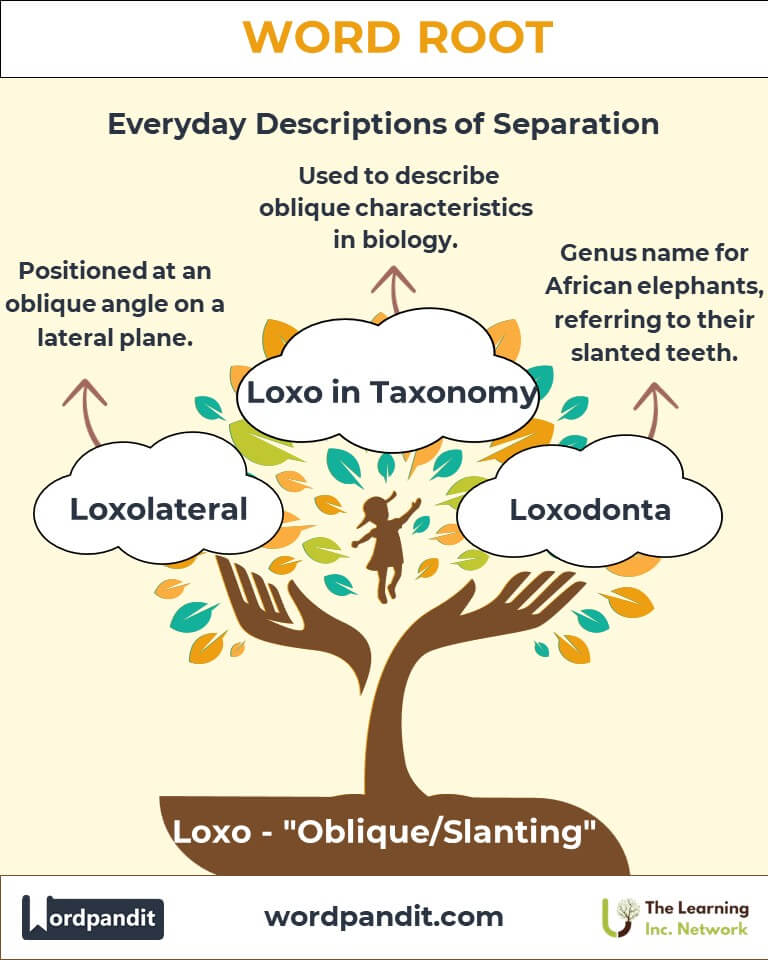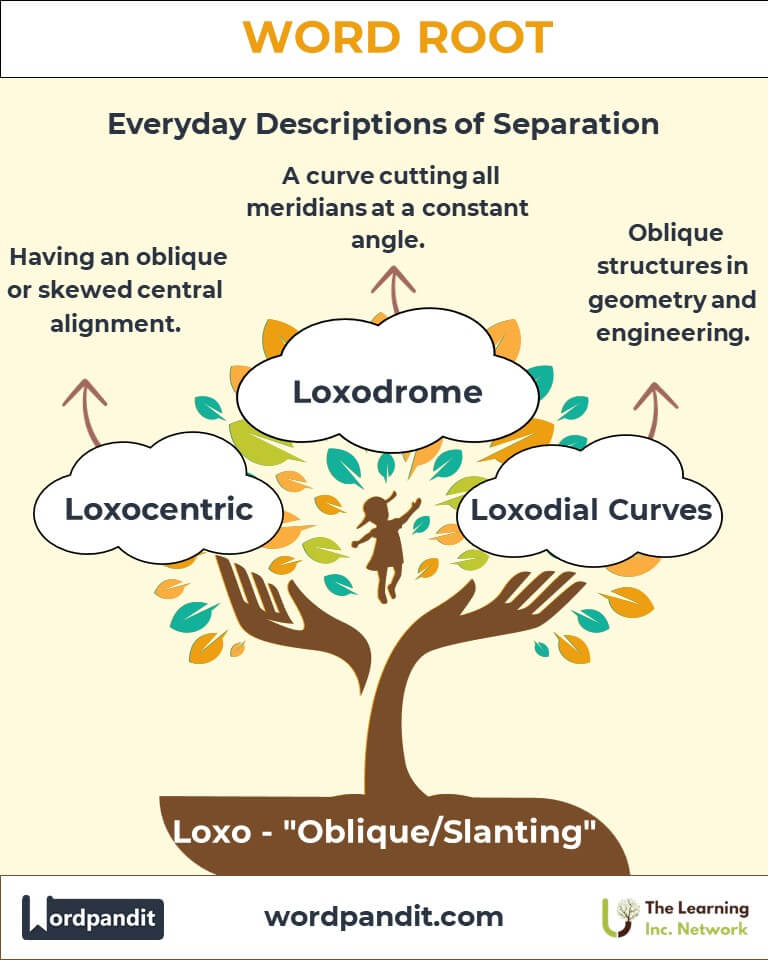Loxo: The Root of Angles and Obliqueness in Language and Science
Dive into the fascinating world of the root "loxo," derived from the Greek word loxos, meaning "oblique" or "slanting." This root is the cornerstone of terms like "loxodrome," describing slanted pathways, and "loxodonta," the genus name for elephants, reflecting their distinctive angular teeth. Explore the evolution, applications, and cultural resonance of "loxo" across disciplines.

Table of Contents
- Introduction: The Essence of "Loxo"
- Etymology and Historical Journey
- Mnemonic: Unlocking the Power of Loxo
- Common Loxo-Related Terms
- Loxo Through Time
- Loxo in Specialized Fields
- Illustrative Story: Loxo in Action
- Cultural Significance of the "Loxo" Root
- The "Loxo" Family Tree
- FAQs about the "Loxo" Word Root
- Test Your Knowledge: Loxo Mastery Quiz
- Conclusion: The Oblique Legacy of Loxo
1. Introduction: The Essence of "Loxo"
The word root "loxo" (pronounced lok-so) represents angles, slants, and oblique forms in language and science. It hails from the Greek word loxos, meaning "oblique" or "slanting," and underpins terms describing diagonal paths and unique structural features. From the mathematical elegance of loxodromes to the biological significance of loxodonta, "loxo" highlights how obliqueness can lead to fascinating discoveries and designs.

2. Etymology and Historical Journey
The root "loxo" traces its origins to the ancient Greek term loxos. The Greeks used the term to describe anything slanting or askew. As scientific knowledge expanded, this root found its way into Latin and then English, enriching disciplines like geometry, navigation, and biology.
- Loxodrome: First coined in the 16th century during the Age of Exploration, describing diagonal navigation paths across the globe.
- Loxodonta: Introduced in the 19th century as the genus name for African elephants, reflecting their slanted, diamond-shaped teeth.
3. Mnemonic: Unlocking the Power of Loxo
Picture an elephant with slanted, diamond-shaped tusks walking along a slanted path that circles the Earth. The tusks remind you of loxodonta, while the path illustrates loxodrome.
Mnemonic Device: "Loxo leads diagonally, from paths to pachyderms."
4. Common Loxo-Related Terms
- Loxodrome (lok-so-drohm): A curve on the globe cutting all meridians at a constant angle.
Example: "The ship’s captain followed a loxodrome to maintain a steady compass bearing." - Loxodonta (lok-so-don-tuh): The genus name for African elephants, referring to their slanted, diamond-shaped molars.
Example: "Loxodonta africana, the African bush elephant, is the largest land animal on Earth." - Loxolateral (lok-so-lat-er-al): Positioned or extending at an oblique angle on a lateral plane.
Example: "The loxolateral muscles were crucial for the creature's unique movement." - Loxocentric (lok-so-sen-trik): Having an oblique or skewed central alignment.
Example: "The artist’s loxocentric designs challenged conventional geometry."
5. Loxo Through Time
- Ancient Navigation: Loxodromes revolutionized maritime travel by providing a constant compass bearing.
- Biological Taxonomy: The naming of Loxodonta emphasized the interplay between physical traits and linguistic precision.
- Modern Geometry: The root persists in technical terms that describe slanted or diagonal properties in structures and designs.
6. Loxo in Specialized Fields
- Navigation: Loxodrome: Essential for understanding navigation paths and maps, especially in the Mercator projection.
- Biology: Loxodonta: Vital in paleontology and taxonomy to differentiate elephant species based on dental characteristics.
- Mathematics: Loxodial Curves: Used in advanced geometry and engineering to model oblique structures and patterns.
7. Illustrative Story: Loxo in Action
Captain Marlow, a 17th-century navigator, relied on loxodromes to chart a steady course to the New World. As he plotted his journey, he admired the slanted stars of the southern sky, which seemed to guide him. Meanwhile, his naturalist companion studied Loxodonta africana fossils, marveling at how even teeth could embody the beauty of obliqueness.
8. Cultural Significance of the "Loxo" Root
"Loxo" captures humanity's fascination with the oblique—from ancient Greek architecture featuring slanted columns to modern design principles. In literature, it symbolizes unconventional paths, embodying creativity and resilience. Its cultural resonance reminds us that deviation from the straight path often leads to innovation.

9. The "Loxo" Family Tree
- Obliqu- (Latin): Meaning slanting; seen in "oblique" and "obliquity."
- Diag- (Greek): Meaning across or through; used in "diagonal."
- Trop- (Greek): Meaning turn; used in "tropism" or "entropy."

FAQs About the Loxo Word Root
Q: What does the root "loxo" signify?
A: The root "loxo" means "oblique" or "slanting." Derived from the Greek word loxos, it describes anything angled, diagonal, or not straight, with applications in geometry, biology, and navigation.
Q: What is a loxodrome, and how is it used?
A: A loxodrome is a curve on a sphere that crosses all meridians at a constant angle. It was historically important in navigation, allowing ships to maintain a steady compass direction over long distances.
Q: Why are African elephants called Loxodonta?
A: The genus name Loxodonta reflects the African elephant’s unique, slanted, diamond-shaped molars. This distinguishing feature inspired the name, emphasizing their oblique dental structure.
Q: How is the term "loxo" relevant in modern mathematics and geometry?
A: In mathematics, "loxo" appears in terms describing slanted or diagonal properties, such as loxodial curves. These concepts are used in advanced geometry, architecture, and engineering.
Q: What does "loxolateral" describe?
A: "Loxolateral" refers to oblique positioning on a lateral plane. It is commonly used in anatomy and design to describe angled alignments or placements on the sides of structures.
Test Your Knowledge: Loxo Mastery Quiz
1. What does the root "loxo" signify?
2. Which term describes angled navigation paths?
3. What inspired the name Loxodonta?
4. What does "loxolateral" describe?
5. In which field is "loxo" prominently used?
12. Conclusion: The Oblique Legacy of Loxo
The root "loxo" celebrates the elegance of obliqueness, weaving through language, science, and culture to highlight the beauty of slanted paths. From navigation to biology, its applications showcase humanity's appreciation for angles and deviations. As we continue to innovate and explore, "loxo" remains a reminder that the most fascinating journeys often take oblique routes.












